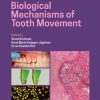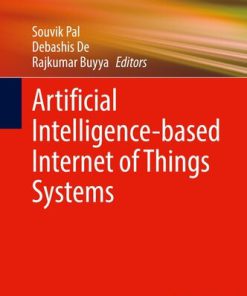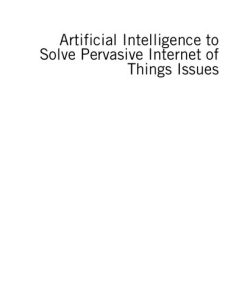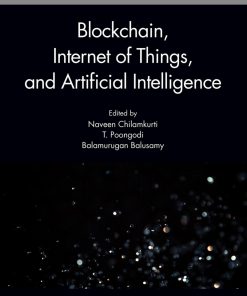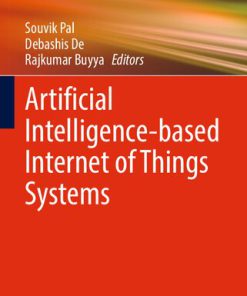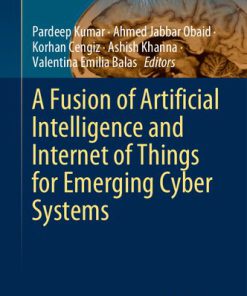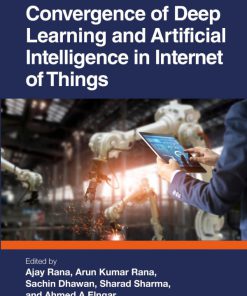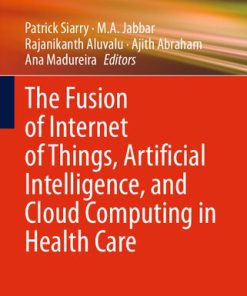Artificial Intelligence for the Internet of Health Things 1st Edition by Shankar, Eswaran Perumaln, Deepak Gupta 0367746905 9780367746902
$50.00 Original price was: $50.00.$25.00Current price is: $25.00.
Artificial Intelligence for the Internet of Health Things 1st Edition by Shankar, Eswaran Perumaln, Deepak Gupta – Ebook PDF Instant Download/Delivery: 0367746905, 9780367746902
Full download Artificial Intelligence for the Internet of Health Things 1st Edition after payment
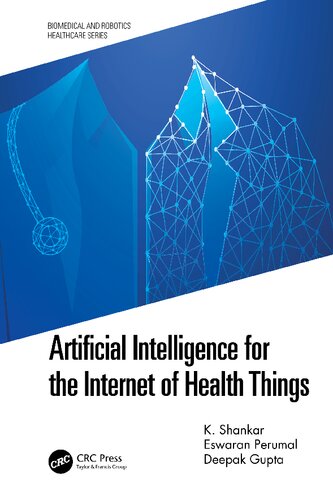
Product details:
ISBN 10: 0367746905
ISBN 13: 9780367746902
Author: K. Shankar; Eswaran Perumal; Deepak Gupta
This book discusses research in Artificial Intelligence for the Internet of Health Things. It investigates and explores the possible applications of machine learning, deep learning, soft computing, and evolutionary computing techniques in design, implementation, and optimization of challenging healthcare solutions. This book features a wide range of topics such as AI techniques, IoT, cloud, wearables, and secured data transmission. Written for a broad audience, this book will be useful for clinicians, health professionals, engineers, technology developers, IT consultants, researchers, and students interested in the AI-based healthcare applications. Provides a deeper understanding of key AI algorithms and their use and implementation within the wider healthcare sector Explores different disease diagnosis models using machine learning, deep learning, healthcare data analysis, including machine learning, and data mining and soft computing algorithms Discusses detailed IoT, wearables, and cloud-based disease diagnosis model for intelligent systems and healthcare Reviews different applications and challenges across the design, implementation, and management of intelligent systems and healthcare data networks Introduces a new applications and case studies across all areas of AI in healthcare data K. Shankar (Member, IEEE) is a Postdoctoral Fellow of the Department of Computer Applications, Alagappa University, Karaikudi, India. Eswaran Perumal is an Assistant Professor of the Department of Computer Applications, Alagappa University, Karaikudi, India. Dr. Deepak Gupta is an Assistant Professor of the Department Computer Science & Engineering, Maharaja Agrasen Institute of Technology (GGSIPU), Delhi, India.
Artificial Intelligence for the Internet of Health Things 1st Table of contents:
Chapter 1 Artificial Intelligence (AI) for IoHT – An Introduction
1.1 Artificial Intelligence (AI) in the Healthcare Domain
1.2 Evolution of AI in the Medical Sector
1.3 Use of AI Devices for Clinical Data Generation
1.4 Types of AI of Relevance to Healthcare
1.4.1 Machine Learning – Neural Networks and Deep Learning
1.4.2 Natural Language Processing
1.4.3 Rule-Based Expert Systems
1.4.4 Physical Robots
1.4.5 Robotic Process Automation
1.5 AI-Based Applications in Healthcare
1.5.1 Patient Engagement and Adherence Applications
1.5.2 Administrative Applications
1.5.3 Implications for the Healthcare Workforce
1.5.4 Ethical Implications
1.6 Conclusion
References
Chapter 2 Role of Internet of Things and Cloud Computing Technologies in the Healthcare Sector
2.1 Introduction
2.2 IoT-Based Healthcare Framework
2.3 Cloud Computing for Healthcare
2.4 IoT-Based Healthcare Services and Applications
2.4.1 IoT Healthcare Services
2.4.1.1 The Internet of m-Health Things
2.4.1.2 Adverse Drug Reactions
2.4.1.3 Community Healthcare
2.4.1.4 Children’s Health Information
2.4.2 IoT Healthcare Applications
2.4.2.1 Glucose Level Sensing
2.4.2.2 Electrocardiogram Monitoring
2.4.2.3 Blood Pressure Monitoring
2.4.2.4 Body Temperature Monitoring
2.4.3 IoT Healthcare: Current Issues and Challenges
2.4.3.1 Cost Analysis
2.4.3.2 Continuous Monitoring
2.4.3.3 Identification
2.4.3.4 Mobility
2.5 Components in IoT-Based Healthcare Services
2.5.1 IoT Devices
2.5.2 Wireless Technologies for IoT
2.5.3 Web Technologies for IoT
2.6 Conclusion
References
Chapter 3 An Extensive Overview of Wearable Technologies in the Healthcare Sector
3.1 Introduction
3.2 Background Information
3.2.1 Quantified Self
3.2.2 Wearable Technology
3.2.3 Advantages of Wearable Technology
3.3 Challenges
3.3.1 Sustainability
3.3.2 Digital Divide
3.3.3 Failure Rates
3.3.4 Lack of Predictive Comparability
3.3.5 Privacy and Security
3.4 Typical Wearable Devices with Applications in Health
3.4.1 Wearable Devices Used for General Health Management
3.4.2 Wearable Biosensors Revolutionizing In-Clinic/Hospital Care
3.4.3 Wearable Biosensors Revolutionizing Specific Fields of Healthcare Outside of the Hospital and Clinic
3.4.4 Regulatory Oversight and Economic Impact
3.5 Conclusion
References
Chapter 4 IoHT and Cloud-Based Disease Diagnosis Model Using Particle Swarm Optimization with Artificial Neural Networks
4.1 Introduction
4.2 The Proposed Model
4.2.1 Data Collection
4.2.2 PSO-ANN Model
4.2.2.1 ANN Model
4.2.2.2 Parameter Optimization of ANN Using PSO
4.2.3 Proposed Diagnostic Model
4.3 Performance Validation
4.4 Conclusion
References
Chapter 5 IoHT-Based Improved Grey Optimization with Support Vector Machine for Gastrointestinal Hemorrhage Detection and Diagnosis Model
5.1 Introduction
5.2 Proposed Method
5.2.1 Preprocessing
5.2.2 Feature Extraction Process Using NGLCM
5.2.3 NGLCM-IGWO-SVM–Based Classification
5.3 Experimental Validation
5.3.1 Data Set Used
5.3.2 Results Analysis
5.4 Conclusion
References
Chapter 6 An Effective-Based Personalized Medicine Recommendation System Using an Ensemble of Extreme Learning Machine Model
6.1 Introduction
6.2 The Proposed Medical Recommender System
6.2.1 Database System Module
6.2.2 Data Preparation Module
6.2.3 Recommendation Model Module
6.2.4 Model Evaluation Module
6.2.5 Proposed Recommendation Model
6.2.5.1 Extreme Learning Machine (ELM)
6.2.5.2 b-ELM Classifier
6.3 Experimental Results and Discussion
6.4 Conclusion
References
Chapter 7 A Novel MapReduce-Based Hybrid Decision Tree with TFIDF Algorithm for Public Sentiment Mining of Diabetes Mellitus
7.1 Introduction
7.2 The Proposed Model
7.2.1 Data Collection
7.2.2 Data Preprocessing and Integration
7.2.2.1 Data Tokenization
7.2.2.2 Generating and Removing Stop Words
7.2.2.3 Detecting Stop Words with SentiCircles
7.2.2.4 Stemming and Lemmatization
7.2.2.5 Corpus Generation
7.2.2.6 Tagging
7.2.3 Data Analysis Stage
7.2.3.1 MPHDT-T-Based Opinion Mining
7.2.3.2 Decision Tree (DT)
7.2.3.3 Term Frequency-Inverse Document Frequency (TFIDF)
7.3 Performance Validation
7.4 Conclusion
References
Chapter 8 IoHT with Artificial Intelligence–Based Breast Cancer Diagnosis Model
8.1 Introduction
8.2 Related Works
8.3 The Proposed Model
8.3.1 Image Acquisition
8.3.2 Preprocessing
8.3.3 HFE Model
8.3.3.1 Homogeneity
8.3.3.2 Energy
8.3.3.3 HOG Features
8.3.4 GA-SVM-Based Classification
8.3.4.1 Chromosome Design
8.3.4.2 Fitness Function
8.3.4.3 Hybridization of the GA-SVM Algorithm
8.4 Performance Validation
8.5 Conclusion
References
Chapter 9 Artificial Intelligence with a Cloud-Based Medical Image Retrieval System Using a Deep Neural Network
9.1 Introduction
9.2 The Proposed DC-DNN Model
9.2.1 DLTerQEP-Based Texture Feature Extraction
9.2.2 Crest Line–Based Shape Feature Extraction
9.2.2.1 Curvature Approximation
9.2.2.2 Crest Point Classification
9.2.2.3 Crest Lines
9.2.3 Euclidean Distance–Based Similarity Measurement
9.2.4 DNN-Based Classification
9.3 Performance Validation
9.3.1 Data Set Used
9.3.2 Results Analysis
9.4 Conclusion
References
Chapter 10 IoHT with Cloud-Based Brain Tumor Detection Using Particle Swarm Optimization with Support Vector Machine
10.1 Introduction
10.2 The Proposed GLCM-PSO-SVM Model
10.2.1 Preprocessing
10.2.2 Feature Extraction
10.2.3 PSO-SVM-Based Classification
10.2.3.1 SVM Classifier
10.2.3.2 Parameter Optimization of SVM Using the PSO Algorithm
10.3 Experimental Analysis
10.3.1 Data Set Description
10.3.2 Evaluation Metrics
10.3.3 Results Analysis
10.4 Conclusion
References
Chapter 11 Artificial Intelligence-Based Hough Transform with an Adaptive Neuro-Fuzzy Inference System for a Diabetic Retinopathy Classification Model
11.1 Introduction
11.2 Proposed Method
11.2.1 Preprocessing
11.2.2 Watershed-Based Segmentation
11.2.3 Hough Transform–Based Feature Extraction
11.2.4 ANFIS-Based Classification
11.3 Performance Analysis
11.3.1 Data Set Description
11.3.2 Results Analysis
11.4 Conclusion
References
Chapter 12 An IoHT–Based Intelligent Skin Lesion Detection and Classification Model in Dermoscopic Images
12.1 Introduction
12.2 The SIFT-SVM
12.2.1 Bilateral Filtering–Based Preprocessing
12.2.2 Image Segmentation
12.2.3 Feature Extraction
12.2.3.1 Detect Scale-Space Extrema
12.2.3.2 Localized Feature Points
12.2.3.3 Assignment of Orientation
12.2.3.4 Feature Point Descriptor
12.2.4 Image Classification
12.3 Performance Validation
12.3.1 Data Set Used
12.3.2 Results Analysis
12.4 Conclusion
References
Chapter 13 An IoHT-Based Image Compression Model Using Modified Cuckoo Search Algorithm with Vector Quantization
13.1 Introduction
13.2 Vector Quantization and LBG Algorithm
13.3 Proposed MCS-LBG Algorithm–Based VQ
13.3.1 CS Algorithm
13.3.2 MCS Algorithm
13.3.3 Working Process of MCS-LBG Algorithm
13.4 Performance Validation
13.5 Conclusion
References
Chapter 14 An Effective Secure Medical Image Transmission Using Improved Particle Swarm Optimization and Wavelet Transform
14.1 Introduction
14.2 The IPSO-DWT Method
14.2.1 Embedded Procedure
14.2.1.1 Representation of the Stego Key
14.2.1.2 Embedded Process
14.2.2 Extraction of the Secret Message
14.2.3 IPSO-Based Pixel Selection Process
14.3 Performance Validation
14.4 Conclusion
References
Chapter 15 IoHT with Wearable Devices–Based Feature Extraction and a Deep Neural Networks Classification Model for Heart Disease Diagnosis
15.1 Introduction
15.2 Proposed Model
15.2.1 IoHT-Based Patient Data Collection
15.2.2 IoHT Medical Data Preprocessing
15.2.3 Heart Feature Extraction
15.2.4 DNN for Data Classification
15.2.4.1 Training of Layers
15.2.4.2 The Stacked Autoencoder
15.2.4.3 The Softmax Layer
15.3 Performance Validation
15.4 Conclusion
People also search for Artificial Intelligence for the Internet of Health Things 1st:
intelligence artificial intelligence
8 examples of artificial intelligence in the workplace
7 disadvantages of artificial intelligence everyone should know about
7 types of artificial intelligence
Tags:
Shankar,Eswaran Perumaln,Deepak Gupta,Artificial,Intelligence
You may also like…
Computers - Artificial Intelligence (AI)
Artificial Intelligence based Internet of Things Systems Souvik Pal (Editor)
Engineering
Computers - Artificial Intelligence (AI)
Computers - Artificial Intelligence (AI)
Artificial Intelligence-based Internet of Things Systems First Edition Souvik Pal (Editor)
Computers - Computer Science
Computers - Networking
Internet of Things Artificial Intelligence and Blockchain Technology R.Lakshmana Kumar (Editor)
Computers - Networking

